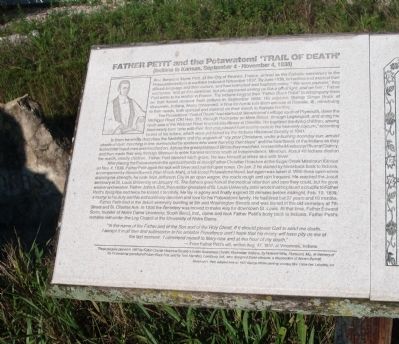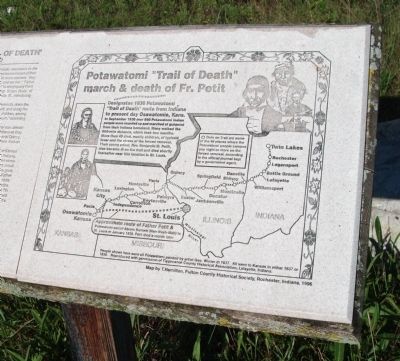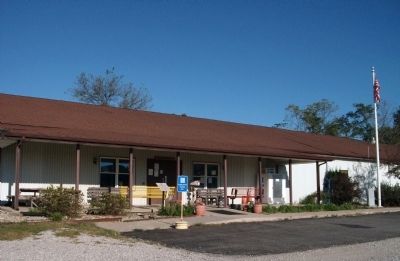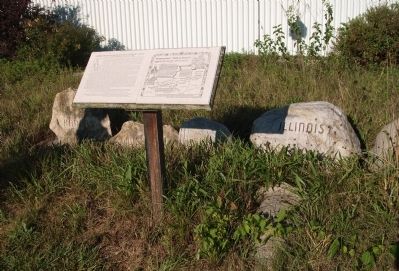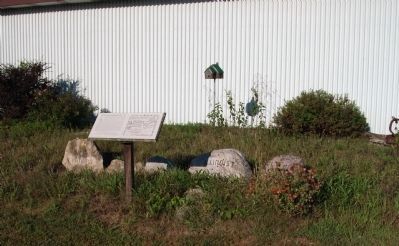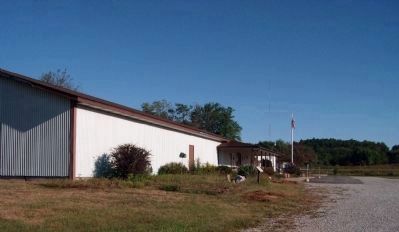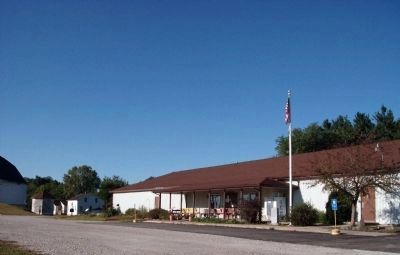Near Rochester in Fulton County, Indiana — The American Midwest (Great Lakes)
Father Petit and the Potawatomi 'Trail of Death'
— Indiana to Kansas, September 4 - November 4, 1838 —
Inscription.
Rev. Benjamin Marie Petit, of the City of Rennes, France, arrived as the Catholic missionary to the Potawatomi Indians in northern Indiana in November 1837. By June 1838, he had learned much of their difficult language and their culture, and had instructed and baptized many. “‘We were orphans,’ they said to me, ‘and as if in darkness, but you appeared among us like a great light, and we live’,” Father Petit wrote to his mother in France. The Indians begged their “Father Black Robe” to accompany them on their forced removal from Indiana in September 1838, His superior, Bishop Simon Brute of Vincennes, Indiana, finally consented, in time for him to join them enroute at Danville, Ill., ministering to their needs, both spiritual and material on their march to Kansas territory.
The Potawatomi “Trail of Death” had started at Menominee’s village south of Plymouth, down the Michigan Road (Old Hwy. 31), through Rochester on Main Street, through Logansport, and along the north side of the Wabash River to cross into Illinois at Danville. He baptized the dying children, among them newly born “who with their first step passed from earthly exile to the heavenly sojourn,” according to one of his letters, which were published by the Indiana Historical Society in 1941.
In them he vividly describes the hardships and the anguish of “my poor Christians, under a burning noonday sun, amidst clouds of dust, marching in line, surrounded by soldiers who were hurrying their steps” and the heartbreak of the Indians as they buried their loved ones and marched on. Across the great prairies of Illinois they marched, crossed the Mississippi River at Quincy, and then made their way through Missouri to enter Kansas territory south of Independence, Missouri. About 40 Indians died on the march, mostly children. Father Petit blessed each grave. He was himself at times sick with fever.
After placing the Potawatomi in the spiritual hands of Jesuit Father Christian Hoecken at the Sugar Creek Mission in Kansas on Nov. 4, 1838, Father Petit again fell sick with fever and painful open sores. On Jan. 2 he started by horseback back to Indiana, accompanied by Abram Burnett (Nan-Wesh-Mah), a full-blood Potawatomi friend, but again was taken ill. With three open sores draining his strength, he rode from Jefferson City in an open wagon, the roads rough and rain frequent. He reached the Jesuit seminary at St. Louis University on January 15. The fathers gave him all the medical attention and care they could, but he grew weaker and weaker. Father John A. Elet, then rector-president of St. Louis University, later wrote that he placed a crucifix to Father
Petit’s dying lips and twice he kissed it tenderly. He lay in agony and finally expired 20 minutes before midnight, Feb. 10, 1839, a martyr to his duty and his extraordinary devotion and love for his Potawatomi family. He had lived but 27 years and 10 months.
Father Petit died in the Jesuit seminary building at 9th and Washington Streets and was buried in the old cemetery at 7th Street and St. Charles Ave. In 1856 the cemetery was moved to make way for downtown St. Louis. At that time, Father Edward Sorin, founder of Notre Dame University, South Bend, Ind., came and took Father Petit’s body back to Indiana. Father Petit’s remains rest under the Log Chapel at the University of Notre Dame.
“In name of the Father and of the Son and of the Holy Ghost. If it should please God to send me death, I accept it in all love and submission to his amiable Providence and I hope that his mercy will have pity on me at the last moment. I commend myself to Mary now and at the hour of my death,”
From Father Petit’s will, written Aug. 17, 1837, at Vincennes, Indiana.
Erected 1997 by Fulton County Historical Society’s Indian Awareness Center, Rochester, IN by Howard Kline, Florissant, Mo. and Tom Hamilton, Leesburg, Ind.
Topics and series. This historical marker is listed in these topic lists: Churches & Religion
• Native Americans. In addition, it is included in the Potawatomi Trail of Death series list. A significant historical year for this entry is 1837.
Location. 41° 6.558′ N, 86° 14.456′ W. Marker is near Rochester, Indiana, in Fulton County. Marker is on U.S. 31 south of County Road W 375 N, on the right when traveling south. Located at the South end (and in front) of - - the Fulton County Museum building. Touch for map. Marker is at or near this postal address: 37 E 375 N Rochester, Indiana, Rochester IN 46975, United States of America. Touch for directions.
Other nearby markers. At least 8 other markers are within 4 miles of this marker, measured as the crow flies. Fulton County War Memorial (within shouting distance of this marker); William Polke House (within shouting distance of this marker); Michigan Road (approx. 1.1 miles away); Site of Indian Village Chippewa-Nung (approx. 1.1 miles away); William Polke Trading Post (approx. 1.1 miles away); The Underground Railroad (approx. 3.3 miles away); Ga bgojwébnegéjuk Mural (approx. 3.3 miles away); W. W. I War Memorial (approx. 3.3 miles away). Touch for a list and map of all markers in Rochester.
More about this marker. These plaques placed in 1997 by Fulton County Historical Society’s Indian Awareness Center, Rochester, Indiana; by Howard Kline, Florissant,
Mo.,
in memory of his Potawatomi grandfather Adam Black Fox; and by Tom Hamilton, Leesburg, Ind., who designed these plaques, a descendent of Abram Burnett.
Sketch of Fr. Petit. Adapted from an 1837 George Winter painting, courtesy Mrs. Cable Bail, Lafayette, Ind.
Also see . . .
1. "Fulton County Museum" : :. (Courtesy of Official Web-Site "Potawatomi - Trail of Death Association" Shirley Willard / Rochester, Indiana.) This article has photos of the marker and other details. (Submitted on September 9, 2010, by Al Wolf of Veedersburg, Indiana.)
2. History and More Items:. This Official Web-site of the "Potawatomi Trail of Death Association" (Shirley Willard / Rochester, Indiana) is the center of activity and information - with many excellent links. (Submitted on September 9, 2010, by Al Wolf of Veedersburg, Indiana.)
3. Video - - "The Potawatomi Trail of Death" ::. Courtesy youtube.com :: An insightful and well done video ! ! (Submitted on April 20, 2011, by Al Wolf of Veedersburg, Indiana.)
Credits. This page was last revised on December 8, 2020. It was originally submitted on September 9, 2010, by Al Wolf of Veedersburg, Indiana. This page has been viewed 1,497 times since then and 28 times this year. Photos: 1, 2, 3, 4, 5, 6, 7. submitted on September 9, 2010, by Al Wolf of Veedersburg, Indiana. • Syd Whittle was the editor who published this page.
